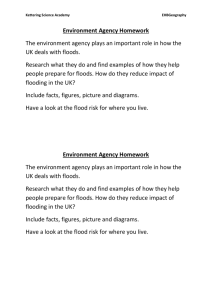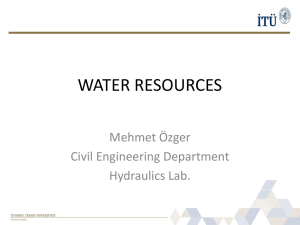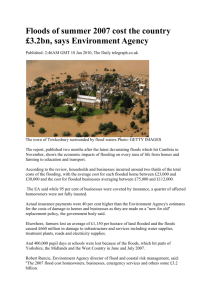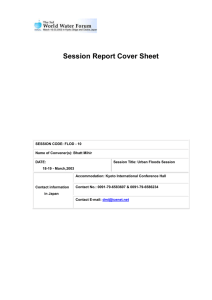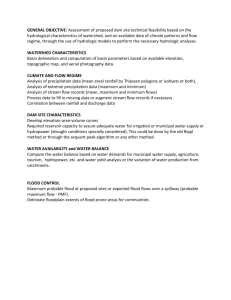A Multi-Level Approach to Developing
advertisement
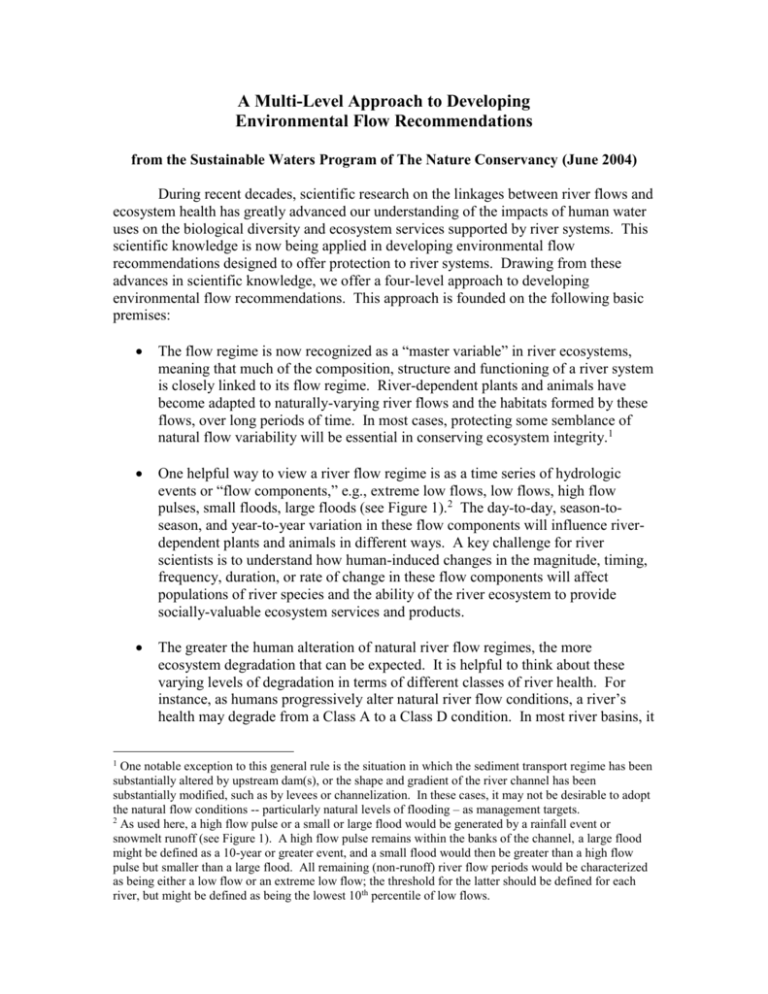
A Multi-Level Approach to Developing Environmental Flow Recommendations from the Sustainable Waters Program of The Nature Conservancy (June 2004) During recent decades, scientific research on the linkages between river flows and ecosystem health has greatly advanced our understanding of the impacts of human water uses on the biological diversity and ecosystem services supported by river systems. This scientific knowledge is now being applied in developing environmental flow recommendations designed to offer protection to river systems. Drawing from these advances in scientific knowledge, we offer a four-level approach to developing environmental flow recommendations. This approach is founded on the following basic premises: 1 The flow regime is now recognized as a “master variable” in river ecosystems, meaning that much of the composition, structure and functioning of a river system is closely linked to its flow regime. River-dependent plants and animals have become adapted to naturally-varying river flows and the habitats formed by these flows, over long periods of time. In most cases, protecting some semblance of natural flow variability will be essential in conserving ecosystem integrity.1 One helpful way to view a river flow regime is as a time series of hydrologic events or “flow components,” e.g., extreme low flows, low flows, high flow pulses, small floods, large floods (see Figure 1).2 The day-to-day, season-toseason, and year-to-year variation in these flow components will influence riverdependent plants and animals in different ways. A key challenge for river scientists is to understand how human-induced changes in the magnitude, timing, frequency, duration, or rate of change in these flow components will affect populations of river species and the ability of the river ecosystem to provide socially-valuable ecosystem services and products. The greater the human alteration of natural river flow regimes, the more ecosystem degradation that can be expected. It is helpful to think about these varying levels of degradation in terms of different classes of river health. For instance, as humans progressively alter natural river flow conditions, a river’s health may degrade from a Class A to a Class D condition. In most river basins, it One notable exception to this general rule is the situation in which the sediment transport regime has been substantially altered by upstream dam(s), or the shape and gradient of the river channel has been substantially modified, such as by levees or channelization. In these cases, it may not be desirable to adopt the natural flow conditions -- particularly natural levels of flooding – as management targets. 2 As used here, a high flow pulse or a small or large flood would be generated by a rainfall event or snowmelt runoff (see Figure 1). A high flow pulse remains within the banks of the channel, a large flood might be defined as a 10-year or greater event, and a small flood would then be greater than a high flow pulse but smaller than a large flood. All remaining (non-runoff) river flow periods would be characterized as being either a low flow or an extreme low flow; the threshold for the latter should be defined for each river, but might be defined as being the lowest 10 th percentile of low flows. is still possible to protect Class A conditions for the foreseeable future. However, in other river basins, society will need to decide what class of river health is to be protected, so that river scientists can offer appropriate environmental flow recommendations. Recommended Four-Level Approach Water managers and planners require assistance from river scientists to define the environmental flow conditions needed to sustain the desired level of river health. Estimates of environmental flow requirements are needed to support water supply planning, water withdrawal permitting, the licensing or planning of dam operations, and for many other purposes. In many instances, estimates of environmental flow needs must be made with very little or no ecological information upon which to base the environmental flow recommendation. The time or money required to conduct a detailed study of environmental flow needs may not be available. In other cases, field data collection or expert judgment can be used to inform the environmental flow recommendations. Recognizing that variable levels of resource availability will necessarily dictate the environmental flow study that can be undertaken, we offer the following four-level approach: 3 Level I is appropriate only when resources are not available to conduct a Level IIIV study, and when very little or no ecological information is available to inform the environmental flow assessment. The recommended approach at this level is based on the understanding that protecting natural flow characteristics will be essential to protecting river health. The approach offered here will require minimal time, effort, and funding. Environmental flow estimates derived at this level should be viewed only as placeholders for water planning or permitting purposes, until more detailed studies can be undertaken. The approach recommended at this level – the “Range of Variability Approach” -- is called a “hydrologic desktop method.” The only data required to apply this approach is a time series of “natural”3 daily river flows, based upon field measurements or model simulations. Level II builds on the first level by convening a workshop with inter-disciplinary scientists to refine the results of the hydrologic desktop method, using primarily professional judgment and general knowledge of the flow conditions required by targeted plants and animals in the river system of interest. Very little or no field data is needed, other than natural daily river flows. This approach can also be This natural daily flow data set can be derived from a variety of sources. If historical records exist for the river from a period in which human influences are thought to be minimal, such as during a “pre-dam” period, these measured flows can be used. Alternatively, human influences can be removed from a historical data set using hydrologic accounting techniques to create a “naturalized” or “unimpaired” data set, or a hydrologic simulation model can be used to create an estimated natural data set. supplemented with a literature review of relevant publications and information pertinent to the flow and habitat needs of targeted plants and animals. Level III builds on the second level by collecting field data to support analysis of the flow needs of targeted plants and animals. Level IV involves on-going refinement of environmental flow recommendations through an adaptive management approach. This will require careful implementation of recommended flows on an experimental basis, during which ecosystem responses are being monitored. Level I – Hydrologic Desktop Method The recommended approach at this level is based upon the “Range of Variability Approach” (Richter et al 1997). The Indicators of Hydrologic Alteration (IHA) software and a “natural” daily flow data set are used to develop environmental flow recommendations. The IHA software separates the daily flow data into five “flow component” categories: extreme low flows, low flows, high flow pulses, small floods, large floods. Graphs similar to those portrayed in Figure 2 are created for the annual averages of the low flows in each month, and for the annual average values of extreme low flows, high flow pulses, small floods, and large floods. The horizontal lines in the Figure 2 graphs divide the annual values into three equal “bins” (i.e., 0-33rd percentile, 34th-66th percentile, 67th-100th percentile). Environmental flow targets can then be described according to the percentage of flow years in which the flows should fall into each of these three bins. For example, to protect a river in a Class A condition, the flows in 1/3 of the years should fall in the lowest bin, 1/3 in the middle bin, and 1/3 in the upper bin. If the river is not going to be protected in a Class A condition, scientists would need to determine other appropriate percentage attainment targets for each of the three bins. Note that at no time should flows drop below the lowest value in the natural flow data. In Figure 3, we have plotted the frequency of occurrence and duration of high flow pulses. Similar graphs can be generated for the timing of events, or the rates of rise and fall for high flow pulses, or small or large floods. As with the graphs of flow magnitude plotted in Figure 2, these types of graphs provide insight into other important characteristics of the flow components. These graphs can be used to determine how often these events should occur, how long they should last, the timing in the year at which they should occur, and how quickly the hydrograph should rise and fall during a high flow or flood event. Using this Level I approach, the environmental flow recommendations would include specification of percentage attainment targets for each of the three bins for: Low flow magnitude in each month Extreme low flow magnitude and the intended frequency of occurrence, duration, and, if deemed appropriate, timing during the year. High flow pulses and their intended frequency of occurrence in each year, as well as their duration, timing, and rates of rise and fall. Small floods and their intended frequency of occurrence (i.e., every 2 years), duration, timing, and rates of rise and fall. Large floods and their intended frequency of occurrence (i.e., every 10 years), duration, timing, and rates of rise and fall. Level II – Experts Workshop This approach supplements the Level I estimates by obtaining inter-disciplinary expert opinion to refine the Level I recommendations. Experts in a variety of relevant river science disciplines are invited to participate in a workshop to discuss the Level I estimates and make adjustments as appropriate, based upon their knowledge of the river of interest and its associated species. At a minimum, the disciplines represented should include hydrology, hydraulics, fluvial geomorphology, aquatic ecology, and riparian ecology. During the workshop, consensus-based adjustments are made to the Level I estimates and all justifications for these adjustments are recorded. This Level II process can be greatly improved by conducting a literature review prior to the workshop. Richter and others (in press) provide greater detail on the background information useful to the process of developing environmental flow recommendations. Level III – Detailed Instream Flow Studies This level builds on Level II by identifying and prioritizing critical data needs and uncertainties during the Level II experts workshop. A suite of field studies is undertaken to fill information gaps, and the results of the studies are used to further refine the environmental flow recommendations developed under Level II. Specific field studies necessary to fill knowledge gaps will vary by river system, but might include channel and floodplain surveys, quantification of flow-floodplain inundation relationships, characterization of sediment budget changes, definition of flowhabitat relationships for representative species, and research to better understand the life histories of representative species. While some of these types of studies can be completed within a field season, others require multiple years. Consequently, it typically takes at least 3-5 years to refine Level II environmental flow recommendations based on Level III studies. Level IV – Adaptive Refinement Level IV can build on any of the other three levels, and does not necessarily need to be preceded by a Level III analysis. Instead, Level IV can be thought of as an operational mode that includes periodically incorporating additional information and advancements in knowledge to improve environmental flow recommendations developed using any of the three other levels. Operating in this way improves the certainty of attaining the biological benefits associated with the environmental flow recommendations over time. This adaptive refinement requires monitoring to enable an evaluation of ecosystem response to a specific set of environmental flow recommendations. To implement Level IV, scientists will need to design and implement a monitoring program focusing on ecosystem indicators that reflect whether the goals of the environmental flow protection are being attained. In essence, Level IV is a way of testing the hypothesis that the flow recommendations will attain the goals of the environmental flow program. The results of this monitoring program should be thoroughly reviewed every five years, at a minimum, and refinements to the flow recommendations should be made accordingly. References Richter, B.D., J.V. Baumgartner, R. Wigington, and D.P. Braun. 1997. How much water does a river need? Freshwater Biology 37:231-249. Richter, B.D., A.T. Warner, J. Meyer, and K. Lutz. A Collaborative and Adaptive Process for Developing Environmental Flow Recommendations. In press, River Research and Applications. Figure 1 Instream Flow Components 7000 6000 River Flow (cfs) 5000 4000 3000 2000 1000 0 Low Flow High Flow Pulses Flood Extreme Low Flow Figure 2. The average November low flows and annual high flow pulse averages for each year of the natural flow data series are plotted in these graphs. The two horizontal bars mark the 33rd and 67th percentile levels in each graph. November Low Flows 12000 10000 River Flow (cfs) 8000 6000 4000 2000 0 1885 1890 1898 1903 1925 1930 1935 1940 1945 Year High Flow Pulses 35000 30000 River Flow (cfs) 25000 20000 15000 10000 5000 0 1885 1890 1898 1903 1925 1930 Year 1935 1940 1945 Figure 3. The annual average frequency of occurrence and duration of high flow pulses for each year of the natural flow data series are plotted in these graphs. The two horizontal bars mark the 33rd and 67th percentile levels in each graph. High Flow Pulse Frequency 35 Number of events per year 30 25 20 15 10 5 0 1885 1890 1898 1903 1930 1925 1935 1940 1945 1940 1945 Year High Flow Pulse Duration 14 Average duration in days 12 10 8 6 4 2 0 1885 1890 1898 1903 1925 1930 Year 1935
